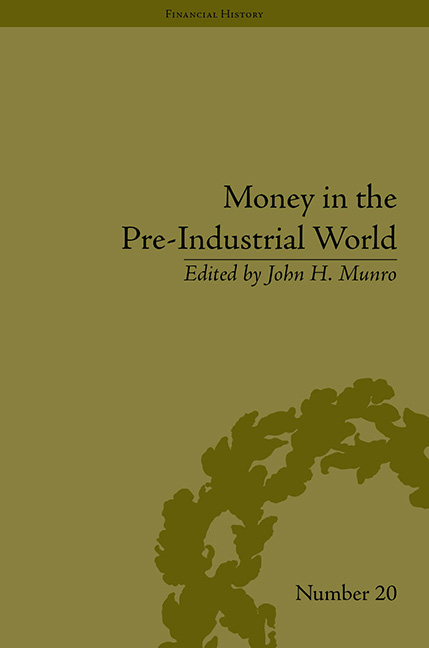Book contents
- Frontmatter
- CONTENTS
- List of Figures and Tables
- List of Contributors
- Introduction
- 1 The Technology and Economics of Coinage Debasements in Medieval and Early Modern Europe: with Special Reference to the Low Countries and England
- 2 From Aurelian to Diocletian: Financing Imperial Recovery by Coinage Debasements and Fiduciary Currencies
- 3 The Making of a Gold Standard: The Ducat and its Offspring, 1284–2001
- 4 Debasement of the Coinage and its Effects on Exchange Rates and the Economy: in England in the 1540s, and in the Burgundian-Habsburg Netherlands in the 1480s
- 5 The Amsterdam Wisselbank's Innovations in the Monetary Sphere: The Role of ‘Bank Money’
- 6 Silver in England 1600–1800: Coinage Outputs and Bullion Exports from the Records of the London Tower Mint and the London Company of Goldsmiths
- 7 The Burdens of Tradition: Debasements, Coinage Circulation and Mercantilist Public Policy Debates in Seventeenth-Century Aragon
- 8 Money or Export Commodity for Asia? American Silver in the Markets of Mexico, Castile and Amsterdam from the Sixteenth to the Eighteenth Century
- 9 Cacao Beans in Colonial México: Small Change in a Global Economy
- 10 Precious Metals, Debasements and Cowrie Shells in the Medieval Indian Monetary Systems, c. 1200–1575
- Notes
- Index
1 - The Technology and Economics of Coinage Debasements in Medieval and Early Modern Europe: with Special Reference to the Low Countries and England
- Frontmatter
- CONTENTS
- List of Figures and Tables
- List of Contributors
- Introduction
- 1 The Technology and Economics of Coinage Debasements in Medieval and Early Modern Europe: with Special Reference to the Low Countries and England
- 2 From Aurelian to Diocletian: Financing Imperial Recovery by Coinage Debasements and Fiduciary Currencies
- 3 The Making of a Gold Standard: The Ducat and its Offspring, 1284–2001
- 4 Debasement of the Coinage and its Effects on Exchange Rates and the Economy: in England in the 1540s, and in the Burgundian-Habsburg Netherlands in the 1480s
- 5 The Amsterdam Wisselbank's Innovations in the Monetary Sphere: The Role of ‘Bank Money’
- 6 Silver in England 1600–1800: Coinage Outputs and Bullion Exports from the Records of the London Tower Mint and the London Company of Goldsmiths
- 7 The Burdens of Tradition: Debasements, Coinage Circulation and Mercantilist Public Policy Debates in Seventeenth-Century Aragon
- 8 Money or Export Commodity for Asia? American Silver in the Markets of Mexico, Castile and Amsterdam from the Sixteenth to the Eighteenth Century
- 9 Cacao Beans in Colonial México: Small Change in a Global Economy
- 10 Precious Metals, Debasements and Cowrie Shells in the Medieval Indian Monetary Systems, c. 1200–1575
- Notes
- Index
Summary
Coinage debasements in pre-industrial Europe, despite their frequency and especially their severity during the late medieval guerres monétaires, and despite their often important economic consequences, remain a subject that is often mentioned but remains ill understood in the economic history literature. Indeed, one often-cited article, aptly titled ‘The Debasement Puzzle’ (1996), by three highly respected economists, sought to demonstrate that coinage debasements were both impractical and economically futile. Yet debasements continued to ‘plague’ Europe until the eighteenth century. The objective of this study is to demonstrate that they were both practical and often quite effective in their often very different goals, and were not always so deleterious in their effects as is traditionally portrayed.
Medieval Coinages and their Relation to Moneys of Account
The nature, techniques and economic consequences of European coinage debasements must be understood first in relation to the local money of account system for that coinage. In medieval and early-modern western Europe (except for the Iberian peninsula and parts of Germany), most local moneys of account were based upon the system that was established under Charlemagne, c.795. It was directly linked to the new Carolingian pound weight of fine silver (489.51 g) in that the pound money of account was given the precise value of this weight of fine silver. Obviously no silver coins weighing a pound were struck; and for centuries, the only silver coins struck were the various regional pennies (and their subdivisions). Solely for accounting purposes, in reckoning prices, wages, values, etc., the pound money of account (libra, livre, lira) was subdivided into 20 shillings (based on the Roman gold solidus), which in turn were subdivided into 12 pence (based on the Roman silver denarius), so that this pound of account always consisted of 240 currently circulating silver pennies. Not until the thirteenth century did some Italian city-states and then France introduce heavier weight silver coins, known as grossi or gros. The primary reason for issuing such larger, ‘full-bodied’ coins was the deterioration in the silver contents of the original penny through the ensuing centuries of almost universal, if periodic coin debasements, and the consequent rise in prices in each region's silver-based money of account.
- Type
- Chapter
- Information
- Money in the Pre-Industrial WorldBullion, Debasements and Coin Substitutes, pp. 15 - 32Publisher: Pickering & ChattoFirst published in: 2014



